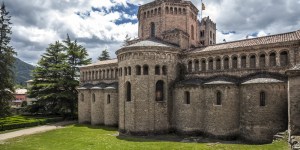By “Gothic,” historians refer to the second of the two major continental eras that flourished in Western and Central Europe during the Middle Ages, the first one being the Romanesque. Gothic art evolved from it, lasting from approximately the mid-12th century to the end of the 16th century in some areas of Europe and even in some regions of the Spanish Empire in the Americas.
If the term “Romanesque” proudly referred to Roman Late Antiquity, based as it was on typical elements of Roman Imperial architecture, the term “Gothic” was originally derogatory. Coined by Italian humanists of the Renaissance who cherished classic Greek and Roman art, the invention of late-medieval architecture was (mistakenly) attributed to the “barbarian” Goths, who allegedly destroyed the Roman Empire and its classical culture in the 5th century, substituting it with what they considered nonclassical ugliness. In fact, the term retained its deprecating, pejorative overtones until the 19th century, when late Romantic artists and thinkers positively re-evaluated Gothic art.
But it is Gothic, right?
Well, no. In truth, Gothic art has nothing to do with the Goths, nor with their (much contested) “invasion” of the Roman Empire. However, the term “Gothic” remains a standard one in the study of art history.
Architecture is the most important, original art form of the Gothic period. Its main structural elements are the invention of medieval builders (and not of the axe-wielding, beer-drinking, long-bearded Goth invaders the Italian Renaissance humanists imagined), who had to solve a series of problems associated with supporting the increasingly heavier masonry ceiling vaults over wide spans.
As monastic orders grew bigger, their monasteries and churches did, too. And the rather heavy stonework of the traditional, Romanesque arched barrel vault exerted a downward-and-outward pressure that pushed the walls upon which the vault rested outward, often making buildings collapse. To keep the building standing, walls had to be extremely thick and heavy, meaning large structures would require a tremendous amount of material, making them ridiculously expensive.
Medieval architects solved this issue with a few brilliant innovations, the ribbed vault being the most important of them all. Arching and intersecting stone ribs support a vaulted ceiling surface made of rather thin stone panels that greatly reduced the weight of the ceiling vault, which no longer needed to rest on a continuous thick wall, but just on certain discrete points of the overall structure, spreading the weight of the ceiling. The round arches of the barrel vault were replaced by pointed arches, which helped distribute thrust in more directions downward, making the building higher, lighter, and brighter, allowing for those empty spaces to be fully covered in stained glass.




